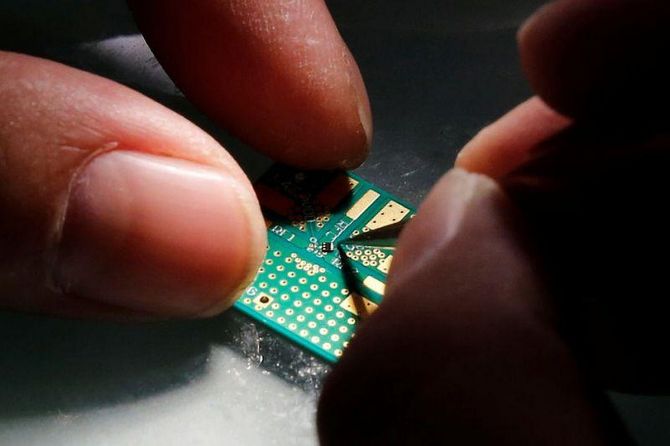Time was when you turned on your car’s ignition, all that happened was that the mechanical system fired up your engine and made it run.

Today, the moment you do so, your stereo system probably lights up, connects to the Bluetooth on your smartphone, and lets you make calls through an audio assistant or play music from your phone, which you can hear on the car’s speakers.
All these smart features in a car are powered by semiconductors, or chips, as they are commonly called.
"We probably still remember how cars used to have cassette players or CD players, and a small display to show the time.
"Now, they have a full-blown display system, depending on whether you have an entry-level or a premium vehicle, and which consumer market it addresses,” says Manish Goel, senior director, system LSI, Samsung Semiconductor India R&D Centre.
“You can check and connect to multiple displays, grab data from multiple sensors to make smart decisions and enable rich user experiences for the passengers in the car.”
A modern car system with advanced features can have anywhere between 2,000 and 3,000 chips that perform various functions, including triggering the sensors for fuel level, airbags, and so on.
The smartphone that you will connect to in your car also has its own system of chips inside, powering everything from calling to touchscreens, Bluetooth to smart cameras, sensing movements to enabling charging. In fact, every single function that a smartphone performs is likely being done by a chip inside.
And now, a chip shortage is leading to delays in the production schedules of automakers.
It will also have an impact on electronics, and the medical devices and networking equipment industries.
The main reasons for the shortage are global and complex, explains Puneet Gupta, director at IHS Markit, a sales forecasting and market research firm.
“There has been a mismatch between different countries’ lockdowns or partial lockdowns and their demand and supply expectations.
"For example, the second wave affected India in April, May and June, and there were no orders.
"Similarly, Malaysia was in the grip of a wave around three months back,” says Gupta.
He adds that everybody in the ecosystem is hoarding or over-buying their stock of chips.
Some are even buying four times their usual stock of requirements.
Moreover, if a chip supplier stands to make a greater profit from a particular carmaker, they prefer to sell to that carmaker over others.
According to recent research by marketing analysis portal Finbold, apart from increasing demand from upcoming 5G capacity building, the semiconductor industry is seeing demand from electric vehicles and the battery industry.
Also, the pandemic has created a tremendous need for connectivity and conferencing solutions globally.
This in turn has driven demand for both in the cloud for solutions that allow people to collaborate and end-user devices such as personal computers and tablets that depend heavily on the semiconductor industry, Finbold added.
The global shortage of chips is also due to geopolitical factors.
A Harvard Business Review (HBR) piece written in February says that the trouble began when the Donald Trump administration last year began to strictly regulate the sale of chips to Chinese firms.
Then, in July and October 2020, fires broke out at two Japanese plants — one provides material to the semiconductor industry, while the other supplies chips to the automotive industry — aggravating the shortage.
Disruptions in the global transportation system have also added to the problem.
While some of the largest global chipmakers have upped their investments, “funding and building a new semiconductor fab is at least a five-year process,” HBR said.
It is the software at the heart of these chips that makes them perform the different functions, says Samsung’s Goel.
“Every year we have a new set of semiconductor chips, and they’re becoming more and more powerful and smart.
"And that has been fuelled by the consumer’s desire to be able to do more in a single device, whether it is a tablet or a smartphone,” he says.
The idea is to pack more capability into less space. So a smaller chip means more processing capability can be added in that space, and more chips can be made from a silicon wafer — the larger component from which chips are cut in a chip manufacturing plant or fab.
The unit of measurement of chips is a nanometer.
The cost of the chip is driven by its size and features.
“And that is physically driven by how much R&D you do, how intelligent you are making your chip, and how many chips you can make from a single wafer,” Goel adds.
Clearly, these are systems that cannot be set up overnight.
Gupta says that the chip shortage is likely to continue for another couple of years, and into the second half of 2023.
(As per industry estimates, while India’s current semiconductor demand is $24 billion, it is expected to reach $100 billion by 2025, giving an indication of the scale of the likely chip shortage in the country.)
Meanwhile, prices for chips used in cars have started going up.
Does this mean that there will be no new cars in the market until the situation returns to normal?
“This can lead to loss of production, demand-supply mismatch, and a focus back on lower variants.
"Customers can also expect longer delays for models and an increase in the waiting period,” says Gupta.
Photograph: Kim Kyung-Hoon/Reuters










